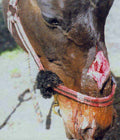Manuka honey and wound healing
 A carefully controlled scientific study found that Manuka honey does indeed improve the healing of lower leg wounds. The effectiveness of Manuka honey, Manuka honey gel (water based containing 66% honey), gel and untreated were compared in both clean and contaminated wounds in the short (12 day) and long term (until healed). 10 horses were used on the trial and all were given full thickness skin wounds on the lower front legs measuring 2cmx2cm. Some wounds were deliberately contaminated by applying horse manure to them for 24 hours to mimick conditions that can be found in a paddock.
A carefully controlled scientific study found that Manuka honey does indeed improve the healing of lower leg wounds. The effectiveness of Manuka honey, Manuka honey gel (water based containing 66% honey), gel and untreated were compared in both clean and contaminated wounds in the short (12 day) and long term (until healed). 10 horses were used on the trial and all were given full thickness skin wounds on the lower front legs measuring 2cmx2cm. Some wounds were deliberately contaminated by applying horse manure to them for 24 hours to mimick conditions that can be found in a paddock.
For the first 12 days the wounds were treated with their assigned treatment programme and bandaged on a daily basis. On day 13 onwards the wounds were left unbandaged to heal, with one leg wound per horse continuing to be treated with Manuka honey gel until healed.
Wounds treated with Manuka honey or Manuka honey gel were smaller from
day 7 of the trial. Interestingly, between days 7 to 28 the contaminated wounds healed faster than the non-contaminated wounds. From day 28 until 42 those wounds treated with Manuka honey or Manuka honey gel healed faster than those treated with gel or left untreated.
The researchers concluded, "Overall wound healing rate was faster for honey and honey gel treated wounds compared to the untreated and gel treated wounds. Long term application of honey gel improved the overall rate of healing compared to all other treatment groups."1.
1. 'The effect of manuka honey on second intention healing of contaminated and uncontaminated wounds on equine distal limbs', A.J. Dart et al, Proc. Australasian Equine Sc. Symp., Vol 3, 2012